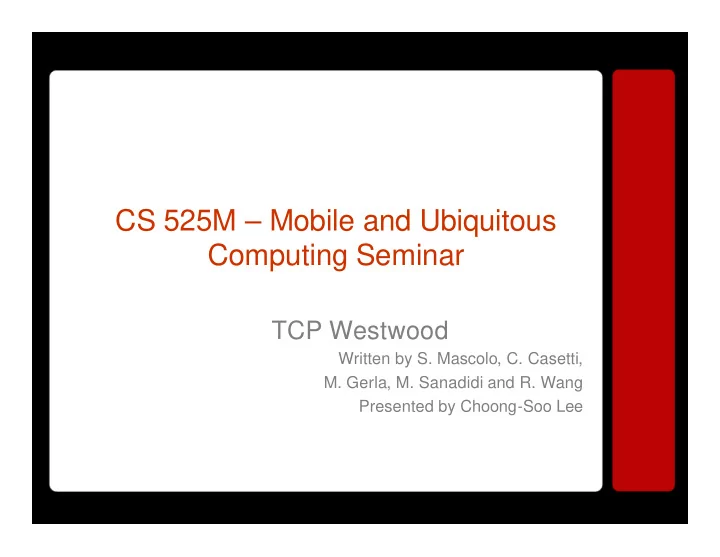

CS 525M – Mobile and Ubiquitous Computing Seminar TCP Westwood Written by S. Mascolo, C. Casetti, M. Gerla, M. Sanadidi and R. Wang Presented by Choong-Soo Lee
Introduction • TCP suffers performance degradation in wireless environment – TCP uses dropped packets as a congestion signal but packets can be lost due to other reasons in wireless environment. – End-to-end, link layer and split connect approaches • Local recovery is more effective than end-to-end approach in handling wireless losses but end-to- end requires minimum support from routers and base stations • Authors propose TCP Westwood, an end-to-end solution to handle wireless losses
Outline • Introduction • TCP Westwood • Evaluation • Conclusion and Future Work
ACK-based measurement • Source performs an end-to-end estimate of the available bandwidth • Enables faster recovery • When an ACK is received, it uses the corresponding data packet size to compute the bandwidth estimate • In case of a DUPACK, an average segment size is used instead.
Filtering ACK Reception Rate • Sample of Bandwidth Estimate d = k b − k t t − k k 1 • We need a low-pass filter to average sampled measurements and to obtain the low frequency components of the samples. τ 2 − 1 − + t t b b = + ˆ ˆ − − k k 1 k k 1 b b τ τ − k k 1 2 2 + + 1 1 − − t t t t − − k k 1 k k 1 τ 1/ : cut-off frequency
Filtering ACK Reception Rate • An Example – Consider constant time interval ( ) ( − 1 a ) = ⋅ + + ˆ ˆ b a b b b − − k k 1 k k 1 2 where a = 0.9 • Real ACKs are irregular and we need to ensure that we have a sample within a certain interval. – Use of a virtual sample of 0 − h 2 m 1 = ˆ ˆ b b + + k h k 2 m 1
Delayed and Cumulative ACKs • Delayed ACK – Send ACK every other in-sequence segment • Cumulative ACK – Acknowledges all segments prior to its sequence number
Delayed and Cumulative ACKs cumul_ack =current_ack_seqno – last_ack_seqno; If (cumul_ack = 0) accounted_for++; cumul_ack = 1; endif if (cumul_ack > 1) if (accounted_for >= cumul_ack) accounted_for = accounted_for – cumul_ack; cumul_ack = 1; else if (accounted_for < cumul_ack) cumul_ack = cumul_ack – accounted_for; accounted_for = 0; endif endif last_ack_seqno = current_ack_seqno; acked = cumul_ack; return acked;
n DUPACKs and Timeout • n duplicate ACKs and coarse timeout imply that there is congestion in the network – ssthresh set to the available pipe size if (n DUPAcKs are received) ssthresh = (BWE * RTTmin) / seg_size; if (cwin > ssthresh) cwin = ssthresh; endif endif If (coarse timeout expires) ssthresh = (BWE * RTTmin) / seg_size; if (ssthresh < 2) ssthresh = 2; endif cwin = 1; endif
Outline • Introduction • TCP Westwood • Evaluation • Conclusion and Future Work
Bandwidth Estimation • TCP Westwood with concurrent UDP Traffic
Fairness • Fairness: flows using the same protocol should get equal share of bandwidth without RED with RED
Friendliness (Simulation) • Friendliness: protocols using different protocols should get equal share of bandwidth • Simulation setup – 2 Mbps bottleneck bandwidth with 100ms round-trip time Num ber of Flow s Achieved Throughput ( Mbps) TCP Reno TCP W estw ood TCP Reno TCP W estw ood 20 0 0.0992 - 0 20 - 0.0994 10 10 0.0913 0.1078
Friendliness (Testbed) • Testbed implementation using Linux
Performance (Setup) • Independent loss model in ground radio environment 2 Mbps 0.01ms 10 Mbps 45ms Base Source Destination Station
Performance • Throughput vs. error rate
Performance • Throughput vs. one-way propagation delay
Performance • Throughput vs. link capacity
Performance • cwin and ssthresh TCP Westwood TCP Reno
Performance • Burst error models – Two state Markov model ? gb Good Bad ? bg – It is used to model fading and blackout.
Performance • Fading – Good State (8 sec, 0.001%) Bad State (4 sec, 0 to 30%) – Throughput vs. error rate Bad State Two-State Model
Performance • Blackout – Good state (4sec) – Bad state (0 to 0.5 sec) (blackout) – Throughput vs. average duration
Performance • Throughput vs. link capacity of the Satellite link
Outline • Introduction • TCP Westwood • Evaluation • Conclusion and Future Work
Conclusion • The authors proposed a new version of TCP, TCP Westwood. – TCP Westwood offers faster recovery without over-shrinking cwin – TCP Westwood’s congestion control relies on both packet losses and bandwidth estimation – TCP Westwood improves performance over wide range of wireless/wired scenarios
Future Work • Include TCP NewReno feature for recovering from multiple losses in the same window • Backward path could be the bottleneck – Need to define fairness between DATA and ACK streams • More comparison between TCP Westwood and link-layer techniques • Further refine bandwidth estimation and filter method for better friendliness • Develop control theoretical model to study TCP Westwood’s stability
Questions ?
Recommend
More recommend